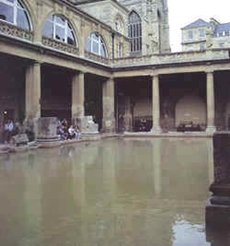Ancient Rome was not as hygienic as imagined
09 Jan 2016
In the popular imagination, the ancient Romans may be best known for their military prowess and laurel wreaths, but they are also considered awesome plumbers with their aqueducts, baths and public toilets.
 The Romans built many structures seemingly dedicated to improving sanitation - in addition to the toilets, they had bathhouses and sewer systems like the giant Cloaca Maxima in Rome.
The Romans built many structures seemingly dedicated to improving sanitation - in addition to the toilets, they had bathhouses and sewer systems like the giant Cloaca Maxima in Rome.
''They [also] introduced legislation so that towns had to clear away the waste from the roads and things and take all that waste mess outside towns,'' says Piers Mitchell, a paleopathologist at the University of Cambridge. ''You'd expect those things to improve the health of the people that lived there as a result.''
But the truth may have been somewhat different, suggests latest research.
In a new paper published in Parasitology, Mitchell reviews several decades of archaeological research to track the presence of parasites before, during, and after the Roman Empire. The evidence suggests that certain parasites - like whipworm, roundworm, and the parasite that causes dysentery - were just as prevalent in the region under Roman rule as they had been during the earlier Bronze and Iron Ages.
Scientists have also found ectoparasites, or parasites that live outside the body - lice, fleas, and bedbugs - suggesting the Romans' bathhouses weren't keeping them much cleaner than people who lived in Viking or medieval times - who also had lice, but no public baths. Archaeologists have excavated fine-toothed combs from the Roman period, presumed to be for removing lice.
Mitchell speculates that perhaps the steamy bathhouses made a good environment for parasites to grow. ''In some baths the water was only changed intermittently, and could acquire a scum on the surface from human dirt and cosmetics,'' he writes.
The parasites also could have benefitted from the Roman practice of fertilizing crops with human poop. This is still done today in some places, and it is good for the plants - if you first compost the poop long enough to kill off any parasite eggs. But the Romans didn't know that.
The ancient Romans' sanitation structures may not actually have been that sanitary, at least by our modern standards, says Ann Olga Koloski-Ostrow, a professor of classical studies at Brandeis University who has been visiting and studying Roman sewers and latrines for more than 40 years.
''In my explorations of public toilets, I have concluded that they must have been pretty dirty places - excrement and urine on the seats and floor, poor lighting … surely, not someplace one would want to spend much time,'' she says.
Koloski-Ostrow noted that while the toilets didn't necessarily have a negative effect on public health, researchers should be careful about saying they had a positive effect.













.jpg)






.jpg)









